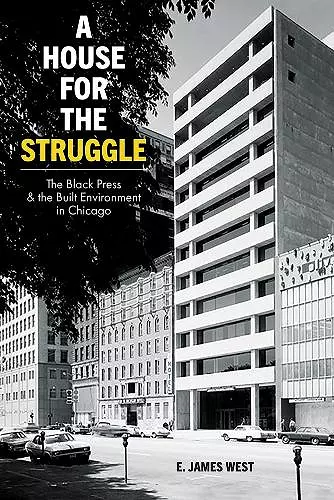A House for the Struggle
The Black Press and the Built Environment in Chicago
Format:Paperback
Publisher:University of Illinois Press
Published:26th Apr '22
Currently unavailable, and unfortunately no date known when it will be back
This paperback is available in another edition too:
- Hardback£91.00(9780252044328)

Multiple Award-Winner!
- Winner of the 2023 Michael Nelson Prize of International Association for Media and History (IAMHIST)
- Recipient of the 2022 Jane Jacobs Urban Communication Book Award
- Winner of the 2023 American Journalism Historians Association Book of the Year
- Winner of the 2023 ULCC’s (Union League Club of Chicago) Outstanding Book on the History of Chicago Award
- Recipient of a 2023 Best of Illinois History Superior Achievement award from the Illinois State Historical Society
- Winner of the 2023 BAAS Book Prize (British Association for American Studies)
- Winner of a 2023 The Brinck Book Award and Lecture series (University of New Mexico School of Architecture + Planning)
- Honorable Mention for the 2021-22 RSAP Book Prize (Research Society for American Periodicals)
Buildings once symbolized Chicago's place as the business capital of Black America and a thriving hub for Black media. In this groundbreaking work, E. James West examines the city's Black press through its relationship with the built environment. As a house for the struggle, the buildings of publications like Ebony and the Chicago Defender embodied narratives of racial uplift and community resistance. As political hubs, gallery spaces, and public squares, they served as key sites in the ongoing Black quest for self-respect, independence, and civic identity. At the same time, factors ranging from discriminatory business practices to editorial and corporate ideology prescribed their location, use, and appearance, positioning Black press buildings as sites of both Black possibility and racial constraint.
Engaging and innovative, A House for the Struggle reconsiders the Black press's place at the crossroads where aspiration collided with life in one of America's most segregated cities.
"A well-conceived, effectively researched, and fascinating book." --Choice
"A House for the Struggle is an eye-opening, compelling read in which West shows that Black press buildings on Chicago’s South Side were symbolic of community pride, unity and success, as well as crucial meeting places in the fight for Black autonomy and civil rights." --NewCity
"A fresh and engaging work that explores how the design of a built environment can often be a destiny. " --Chicago Review of Books
"A House for the Struggle breaks new ground by assessing Chicago's Black newspapers and magazines together, and by connecting them to the buildings and neighborhoods where they operated. E. James West reminds us that journalists with national reach and tremendous ambition still faced the frustrations and indignities of life in a segregated metropolis, and he helps us to understand Chicago as the true capital of the twentieth-century Black press."--Julia Guarneri, author of Newsprint Metropolis: City Papers and the Making of Modern Americans
"A House for the Struggle provides fresh insights into the history of the Black press in Chicago. Through the lens of the built environment, West's compelling narrative takes us inside the newsrooms of the Defender, Ebony, and other rival publications--from their humble origins to the height of their power. But what makes this book extraordinary is how West examines these shifting Black spaces of journalism as crucial sites of intellectual labor, ideological debate, and enterprise that profoundly shaped Chicago urban history, Black identity, and protest politics in twentieth century America."--Erik S. Gellman, author of Troublemakers: Chicago Freedom Struggles through the Lens of Art Shay
"A fresh and engaging work that explores how the design of a built environment can often be a destiny. " --Chicago Review of Books
"West's A House for the Struggle is a well-written and thought-provoking chronicle of urban, media, African American, labor, and cultural history. The connections between political, spatial, economic, and cultural institutions were unique and other cities could model a similar investigation on the local built environment of African American industry." --H-Net Reviews
ISBN: 9780252086397
Dimensions: 229mm x 152mm x 25mm
Weight: 454g
296 pages